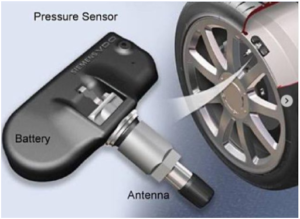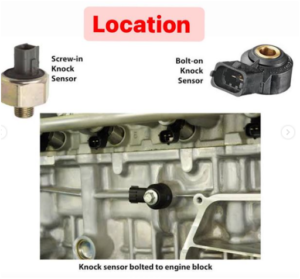Table of Contents
“Automobile Vehicle Sensor TPMS And IAC VALVE, KNOCK Sensor Working, Principle Types And Location-2024”
Introduction
Explore the cutting-edge world of automotive technology with insights into three crucial components—Tire Pressure Monitoring System (TPMS), Idle Air Control (IAC) Valve, and Knock Sensor. From real-time tire pressure monitoring to precise engine idling control and vibration detection, these innovations are reshaping the driving experience. Join us as we unravel the complexities and significance of TPMS, IAC Valve, and Knock Sensor in today's vehicles.
Tpms Sensor (Tire Pressure monitoring system)
A tire-pressure monitoring system (TPMS) is an electronic system designed to monitor the air pressure inside the pneumatic tires on various types of vehicles. A TPMS reports real-time tire-pressure information to the driver of the vehicle, either via a gauge, a pictogram display, or a simple low-pressure warning light. TPMS can be divided into two different types – direct (dTPMS) and indirect (iTPMS). TPMS are provided both at an OEM (factory) level as well as an aftermarket solution. The goal of a TPMS is avoiding traffic accidents, poor fuel economy, and increased tire wear due to under-inflated tires through early recognition of a hazardous state of the tires. This functionality first appeared in luxury vehicles in Europe in the 1980s.
There are two different types of systems being used today
Direct TPMS
Indirect TPMS
Direct TPMS
- Uses a sensor mounted in the wheel to measure air pressure in each tire.
- Provides actual tire pressure readings.
- More accurate than indirect TPMS.
- Battery lasts about a decade.
- No need to reset after tire rotation and inflation.
Indirect TPMS
- Tire pressure measured from the rate of wheel revolution.
- May be inaccurate if new tires are a different size.
- Typically less expensive than direct TPMS.
- Must reset after every tire rotation and inflation.

The TPMS indicator is a light on the dashboard that indicates that your tire pressure may be low and should be checked

The TPMS algorithm will detect a pressure drop based on the roll-radius and frequency information and will show a warning in the instrument cluster.



IAC valve
An idle air control actuator or idle air control valve is a device commonly used in fuel-injected vehicles to control the engine’s idling rotational speed. In carburetted vehicles a similar device known as an idle speed control actuator is used.




Knock Sensor uses piezoelectric
- The sensor principle:
- Knock sensor uses a piezoelectric element.
- Works on the piezoelectric effect.
- Piezoelectric elements generate voltage when pressure or vibration is applied to them.
- Common materials include ceramic and single crystal materials such as quartz, tourmaline, and gallium phosphate.
Working of the Sensor
- Knock sensor generates voltage when vibration is applied to it, utilizing the piezoelectric effect.
- Due to the vibration, a counterweight inside the sensor applies pressure on the piezo element.
- This pressure creates an electric charge in the piezo element, which serves as the output signal of the sensor.

Frequently Asked question
What is a TPMS valve?
A TPMS valve refers to the valve stem and sensor assembly in a tire pressure monitoring system. It is a crucial component that measures and reports the air pressure in a vehicle's tires.
What is the purpose of the TPMS system?
The TPMS system is designed to monitor the air pressure in the pneumatic tires of vehicles in real-time. Its primary purpose is to alert the driver to low tire pressure, helping prevent accidents, improve fuel efficiency, and reduce tire wear due to under-inflation.
What does TPMS mean on your dashboard?
When you see "TPMS" on your dashboard, it indicates an alert from the Tire Pressure Monitoring System. This warning suggests that there may be an issue with the tire pressure, and it's advisable to check the tires for proper inflation.
What is TPMS servicing?
TPMS servicing involves maintaining and ensuring the proper functioning of the Tire Pressure Monitoring System. It includes checking and replacing sensors, calibrating the system, and addressing any issues related to tire pressure.
What are the 2 types of TPMS systems?
There are two main types of TPMS systems: Direct TPMS (dTPMS) and Indirect TPMS (iTPMS). Direct systems use sensors inside each tire to measure pressure, while indirect systems infer tire pressure based on other vehicle parameters like wheel speed.
What is TPMS vs TPMS?
It seems there might be a typo in your question. If you intended to ask about something specific, please provide clarification.
Is TPMS necessary?
TPMS is considered necessary for modern vehicles as it enhances safety by providing real-time information about tire pressure. Properly inflated tires contribute to better vehicle handling, fuel efficiency, and overall road safety.
Where is the TPMS sensor located?
TPMS sensors are typically located on the inner side of the tire, attached to the valve stem. They may be integrated into the valve stem or secured to the rim inside the tire.
How does TPMS work without a sensor?
TPMS systems require sensors to directly measure tire pressure. However, some vehicles use indirect TPMS, which estimates tire pressure based on factors like wheel speed. Direct TPMS is generally more accurate.
What is TPMS failure?
TPMS failure refers to a malfunction or breakdown in the Tire Pressure Monitoring System. This can include sensor malfunctions, communication errors, or other issues that prevent the system from accurately reporting tire pressure.
How do you solve TPMS?
Resolving TPMS issues involves identifying the specific problem. This may include checking and adjusting tire pressure, replacing malfunctioning sensors, or addressing system calibration issues. Professional help may be required for more complex problems.
Can I still drive with TPMS?
While you can still drive with a TPMS warning, it is strongly recommended to address the issue promptly. Ignoring low tire pressure may lead to reduced fuel efficiency, increased tire wear, and, in extreme cases, compromised vehicle safety.
For Buy Sensor Online Here is the best sensor purchasing link
Tpms Sensor
IAC Valve
For those hungry for more knowledge, our exploration doesn't end here. Dive deeper into the world of engineering and design with these captivating reads:
- What Is The Continuously Variable Transmission And What Are Advantage
- Efficiency in Process Automation Companies
- Revolutionizing Fire Safety with Drones
Embark on a knowledge expedition, and let the mysteries of thermodynamics fuel your curiosity. Happy exploring!
Credit Wikipedia for External Link
Very good
Quality posts is the important to interest the people to visit the site, that’s what this website is providing.
I really like reading a post that can make
people think. Also, thanks for allowing me to comment!
Definitely believe that which you said. Your favorite reason seemed
to be on the net the easiest thing to be aware of. I say to you, I certainly get annoyed
while people think about worries that they plainly do not know about.
You managed to hit the nail upon the top and also
defined out the whole thing without having side-effects ,
people could take a signal. Will probably be back to get more.
Thanks
Superb, what a website it is! This weblog presents helpful information to us, keep it up.
We are a gaggle of volunteers and starting a brand new scheme in our community.
Your site offered us with useful information to
work on. You’ve performed a formidable task and our whole neighborhood might
be grateful to you.
These are genuinely enormous ideas in on the
topic of blogging. You have touched some fastidious things
here. Any way keep up wrinting.
I was suggested this web site by my cousin. I’m not sure whether this post is written by him as nobody else know such detailed about my problem.
You’re amazing! Thanks!
I’m really impressed with your writing skills as well as with the layout on your weblog.
Is this a paid theme or did you customize it yourself?
Anyway keep up the excellent quality writing, it’s rare to see a nice blog like this one nowadays.
It is perfect time to make some plans for the longer term and it’s time
to be happy. I have read this post and if I may I want to suggest you some interesting issues or advice.
Perhaps you could write next articles regarding this article.
I wish to read more things approximately it!
Hi to all, the contents present at this web page are actually remarkable for people experience, well,
keep up the good work fellows.
I think the admin of this web site is really working hard
in support of his web site, for the reason that here
every data is quality based data.
This info is worth everyone’s attention. When can I find out more?
Hi, I do think this is a great site. I stumbledupon it 😉 I’m going to revisit
once again since I bookmarked it. Money and freedom is the greatest way to change, may you be rich
and continue to help others.
Having read this I thought it was very informative.
I appreciate you spending some time and effort to put this short article together.
I once again find myself personally spending a significant amount of time both reading and leaving comments.
But so what, it was still worth it!
Hello, yeah this piece of writing is genuinely
fastidious and I have learned lot of things from it on the topic of blogging.
thanks.
I am really inspired together with your writing skills and also with the structure to your weblog.
Is this a paid subject matter or did you customize it yourself?
Either way stay up the excellent high quality writing, it is uncommon to look a great blog
like this one nowadays..
For hottest information you have to visit world-wide-web
and on internet I found this website as a best site for most recent
updates.
If some one desires expert view about running a blog then i propose him/her to visit this website, Keep
up the fastidious job.
It’s truly very complex in this busy life to listen news on Television, so I just use internet for that reason, and obtain the
newest information.
Great post! We are linking to this particularly great article on our website.
Keep up the good writing.
Simply wish to say your article is as astonishing. The clarity in your submit is simply
nice and that i can suppose you are knowledgeable on this
subject. Well along with your permission allow me to grasp your feed to keep updated
with impending post. Thanks a million and please keep up the gratifying work.
I could not resist commenting. Perfectly written!
Wow! At last I got a webpage from where I be capable of actually
take helpful facts regarding my study and knowledge.
If you are going for best contents like myself, simply visit this web page everyday for
the reason that it provides quality contents, thanks
Appreciating the dedication you put into your site and detailed information you present.
It’s awesome to come across a blog every once in a while that
isn’t the same outdated rehashed information. Fantastic read!
I’ve saved your site and I’m including your RSS feeds to my Google account.